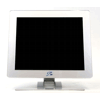Realistically Augmented 2D? The Neurok Optics 17" 3D LCD Monitor
Setup, Appearance And Initial Impression
The monitor is aesthetically pleasing, featuring a smooth silver finish, unobtrusive button/menu system and a funky stand. My only thought is the bezel surrounding the display consumes a fair amount of real estate. At first I thought the footprint could have packed a 19" but I'm no electrical engineer, just an armchair critic.
The height and tilt are easily adjustable, which helps when setting up the perfect perspective to take maximum advantage of the 3D presentation. To achieve the stereo imaging effect the monitor actually contains two LCD panels, which makes for a heavier and thicker case than other LCDs. Neorok Optics might want to look into modifying the base to include a horizontal swivel adjustment, but that's no biggie as users can simply re-orient the stand.
One of the company's goals was to provide a monitor capable of delivering "in-screen/out-of screen" displays through a medium that wouldn't cause the same spatial distortion leading to the "physical rebellion" that occasionally plagues other solutions. The promotional materials state that the system supports "long-time viewing without causing fatigue or eyestrain, headache or nausea".
Users can alter the "depth" at which the stereo frames are projected, which affects how "3D" the scene appears. The "position" of the screen can also be modified, which allows you to set the 3D appearance of the image deeper within the monitor or project it to pop out and emerge further towards the viewer.
The screen surface of the monitor itself is quite reflective. We sometimes found the reflection hard on the eyes when using stereo mode, and glare became especially noticeable when playing through dark scenes for extended periods.

| Advertised Monitor Specifications | |
|---|---|
| iZ3D Monitor Specifications | |
| LCD Size | 17" |
| Resolution | 1280x1024 |
| Contrast (typical) | 400:1 |
| Contrast (max) | 600:1 |
| Display Colors | 16.7 million |
| Display Area | 337.9 x 270.3 mm |
| Pixel Pitch | 0.264 mm |
| Response Time | 8 ms |
| Viewing Angle | 140° horizontally / 130° vertically |
| Test Setup and Settings | |
|---|---|
| System Hardware | |
| Processor(s) | Intel Pentium 43.4 GHz, 2 MB L2 Cache |
| Platform | Shuttle XPC, FD31V10 motherboardIntel i945G/GZ chipsetPhoenix Technologies LTD Bios Ver. 6.0 |
| RAM | Kingston1024 MB @ DDR2/PC2-5300 (CL5.0-5-5-15) |
| Hard Drive | Western Digital Raptor, WD1500AHFD150 GB, 10,000 RPM, 16 MB cache, SATA/150 |
| Networking | OnBoard Broadcom Netlink Gigabit Ethernet |
| Graphics Cards | Nvidia GeForce 7600GT, 256 MB GDDR3560 MHz Core Clock700 MHz Memory Clock (1.4 GHz DDR) |
| Power Supply | SilentX 350 W |
| Monitor | iZ3D Monitor |
| System Software & Drivers | |
| OS | Microsoft Windows XP Professional 5.10.2600, Service Pack 2 |
| DirectX Version | 9.0c (4.09.0000.0904) |
| Graphics Driver(s) | NVIDIA - Forceware 91.31 |
Benchmarks were run at high detail settings and save resolution; we made no further adjustments. Our logic behind this was to showcase the differences between 2D presentation and the performance hit expectations you should have when rendering the stereo optics required for 3D.
Stay On the Cutting Edge: Get the Tom's Hardware Newsletter
Get Tom's Hardware's best news and in-depth reviews, straight to your inbox.
Current page: Setup, Appearance And Initial Impression
Prev Page Introduction Next Page 3D Mode Not Without Its GlitchesMost Popular



